Nutanix AOS 5.0 - Big Update

In the last days of the old, 2016, the company energized itself and released the long awaited "major" release 5.0 of our Acropolis OS. This, I remind you, is what is inside our CVM, Controller VM, and which contains almost all the rich functionality of Nutanix as a system.
There are many new products in it, only a simple listing will probably take a page. Therefore, I decided to stop in this article only on the most interesting and important from the point of view of developing Nutanix as a product, or useful to a practical system administrator working with such a system.
So, AOS 5.0, the third big software release in 2016, and an interesting start for the new year 2017 at the company, which went public in September and became one of the most successful unicorns of 2016 at NASDAQ (companies valued at one billion dollars) and higher).
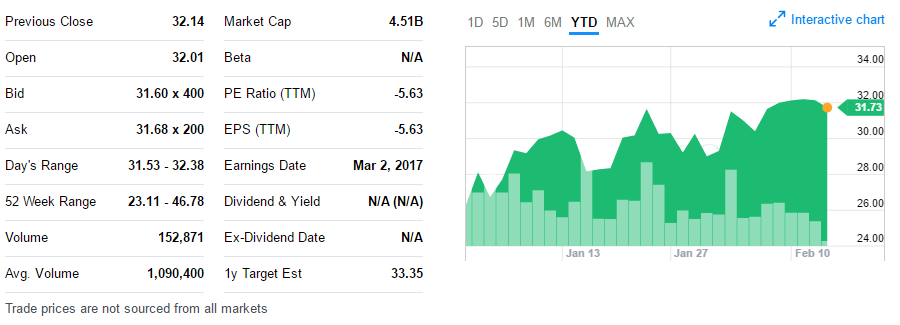
First of all, I would like to tell and show the feature that our users have long been asking for. And finally, Nutanix made the SSP, Self-Service Portal, our own tool for creating “cloud portal” for users, our “vCloud Director”, an interface that allows users of a certain LDAP / AD group to create and deploy from their own system-approved templates VM on the Nutanix AHV platform. A group of users (for example: Test dept, developers, techsupport) receives some resource limits (for example, 100Ghz CPU power, 12TB RAM, 1800GB storage), and within these limits deploys its VMs from its own web interface without worrying about these system administrators' requests .
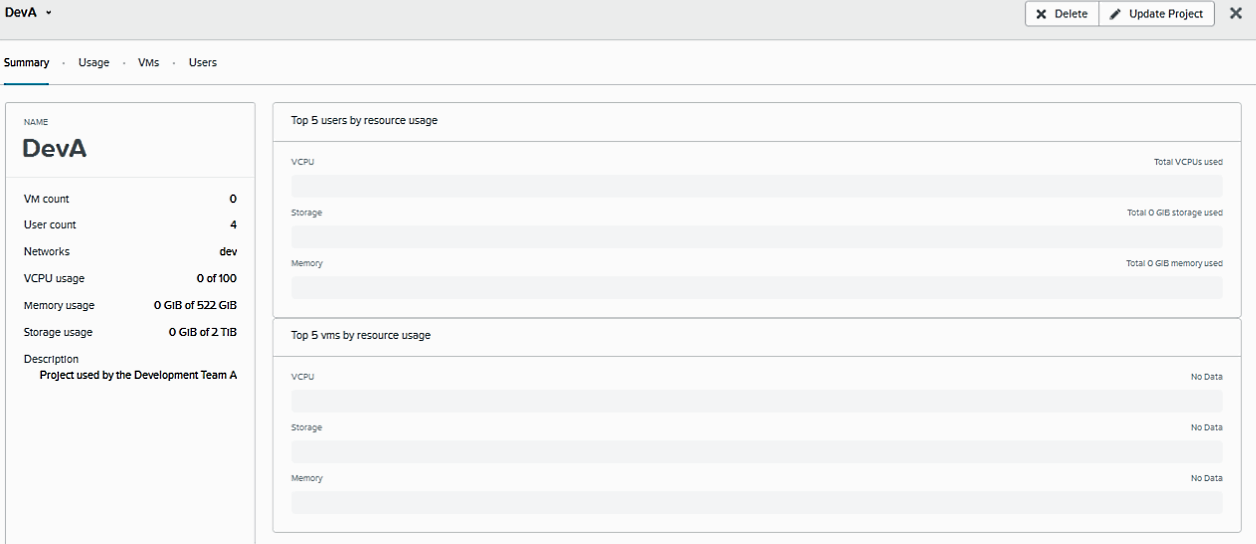
For a company in which hundreds of VMs are deployed, or in which there are dozens of structural divisions, or for a company that wants to make a private cloud for itself (or for certain external users), this is a great new opportunity. And before such a portal could be written using our RESTful API, but now not only the user receives a ready-made, free, out of the box ready-made tool for using it, but the API itself has been significantly expanded and has grown to “v3. 0 ".
So it’s gradually becoming clear that Nutanix officially began to call itself An Enterprise Cloud Company last year.. The advent of SSP has shown Nutanix this year's direction. We are no longer just a startup company that puts its Virtual Appliance on ODM Supermicro, take it higher. And this year you will see a lot of interesting things in this direction.
I must say right away that the first version of SSP released is not ideal, and in the next release, very soon, its capabilities will be significantly expanded, for example, it will be possible to work with several ADs, which means a much richer multi-tenancy will appear , but, not only AHV, our own free hypervisor, but some others will also be supported.
But now you can see how SSP works. And, pay attention, SSP appeared not only on the "commercial" Nutanix, it is also on Nutanix CE!

If you are interested in understanding how to install and use SSP in detail, I recommend the series of posts of our employee Magnus Andersson: http://vcdx56.com/category/ssp/
It does not seem surprising that Nutanix first rolls features to our own hypervisor. It is the most native and native for us, and the number of AHV users on our systems exceeded 30% of the installed systems visible to the support (and there are also systems that the support does not see).
We continue to expand its functionality, for example, in this version of the hypervisor we added our DRS version, Dynamic Resource Scheduler (I recall that in ESXi this functionality is available only in the Enterprise license), as well as Affinity and Anti-Affinity Rules closely related to it. In a nutshell, this is an opportunity to set the rules for compliance with which the VM migration procedure will be checked by the user, or by HA. For example, you can set rules under which VM data will always migrate only to certain hosts, for example, on which there are special resources for their work, and those belonging to this group will always be located on different hosts, for example, they are an HA pair of some kind then the service and fault tolerance should always work on different virtualization hosts.
In addition, now, to deploy a new VM on a cluster, the least physically loaded host will be selected using the same DRS.
Last year, Nutanix began the process of separating functions in our own system management interface - the Prism GUI. Let me remind you that each Nutanix system has a web-based interface for managing the entire cluster, written in pure HTML5, without using Java or Flash. All the functionality that was in Prism - remained, but now we call it "just" Prism, built into the nodes of Nutanix - Prism Elements. It is, as before, built-in and free, and nothing was “cut out” of it. And here are some new “heavy” features that are interesting to the enterprise, are now added to a product called Prism Pro, and it is based on our separate VM application - Prism Central. Initially, Prism Central was a VA with many capabilities for managing multiple clusters, centralized collection of alerts from different clusters, and an integrated management interface. Therefore, when the question arose of how to preserve the relatively lightweight built-in Prism, and at the same time add new features to the interface, it was decided to put some of the "heavy" features for the enterprise, called Prism Pro, into the Prism Central interface.
Prism Pro is a set of additional features that are interesting for “heavy” enterprise installations, and goes for extra money, while the original Elements remained light and simple, and, importantly, free.

Of the interesting new features, an interesting new feature can be mentioned.Search directly in the user interface . Now you can google directly in Prism. Write a query, and probably in the search results you will immediately receive the search. Now the familiar query language, variables, Boolean operations are supported.
For example, the admin wanted to see which OSs are used in his VM. The query “vms os” in the search bar in the interface, and, as you can see, the result plate is already shown in the Top Results field on the left. Want to get a list of VMs that show performance above 1000 IOPS - again no problem “vms IOPS> 1000” will show you them.

In the same place, Prism Pro introduced the Predictive Analysis and What-If function, which is very necessary for large systems .
How soon will I run out of memory on the hosts of the cluster, if everything goes on, how is it going now? What happens if I need to deploy another 10 VMs with SQL Server load of such parameters? What Nutanix hosts will I need to buy for them and when?
All such questions can be answered in Prism Pro and the new interface features.
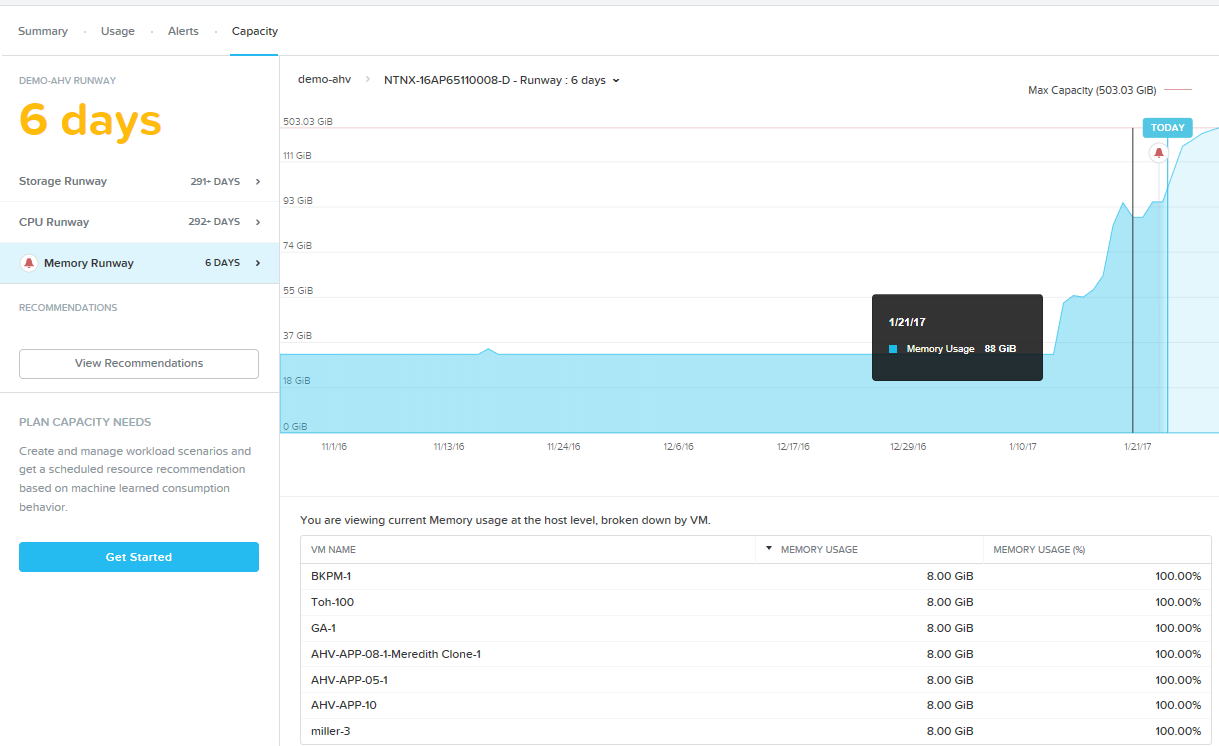
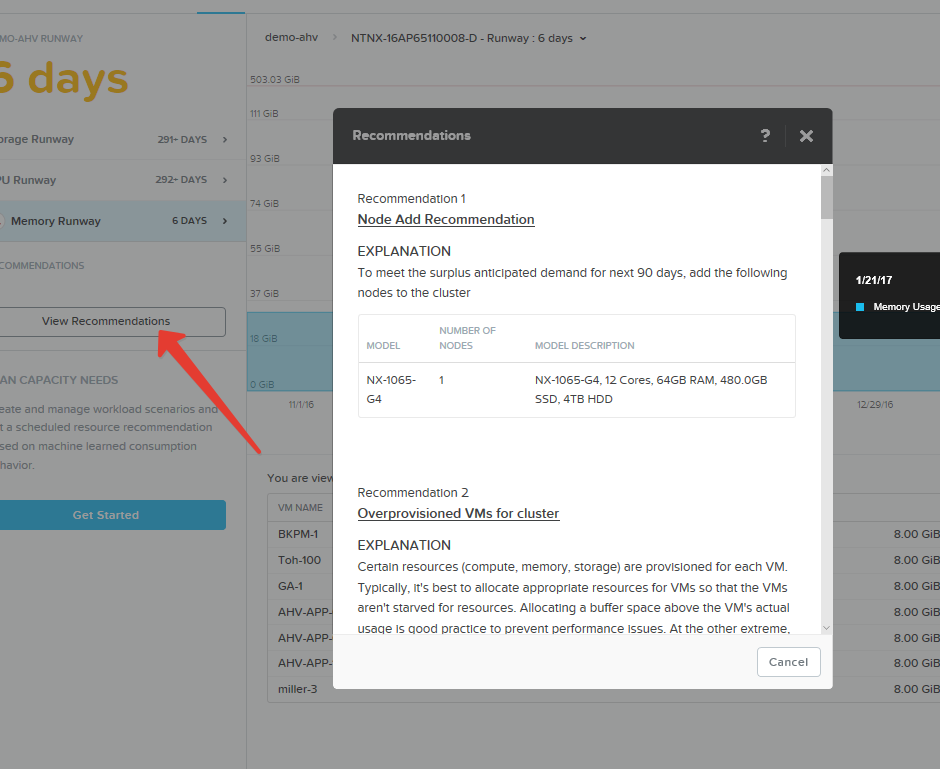
But not only in Prism Pro there were new items. Developed by Prism Elements.
For example, it appeared visualization of the virtual network infrastructure of the cluster . When there are tens and hundreds of VMs in a cluster, when they are scattered across multiple cluster hosts, it can sometimes be difficult to figure out which host, VLAN, and interface a particular VM belongs to. Now, in the Network panel, you can quickly view and analyze the entire network.
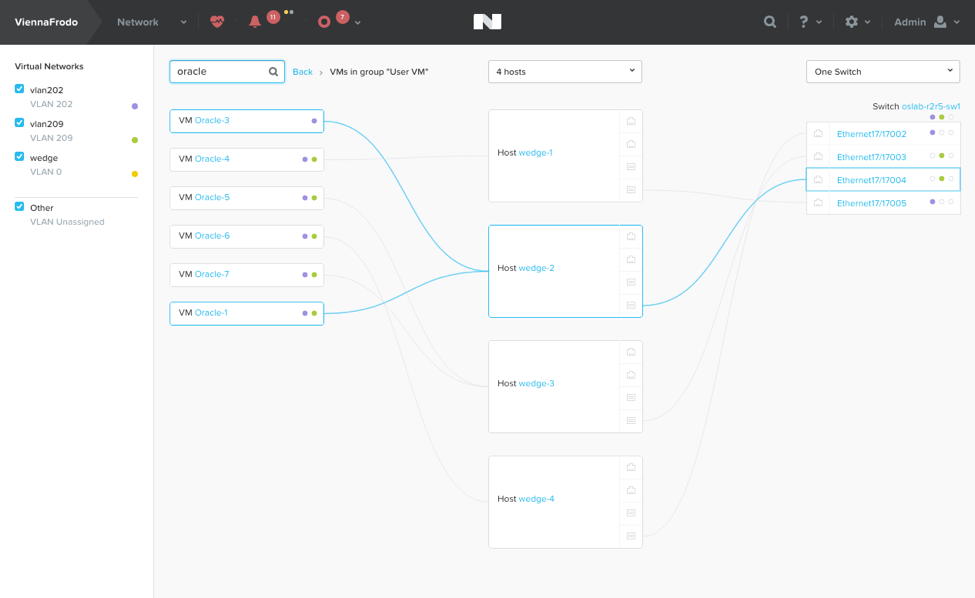
There you can see statistics on ports, physical, host, and virtual, VM. In addition, if your switch supports the LLDP protocol, then configuration data from the physical switch can also be obtained and analyzed.
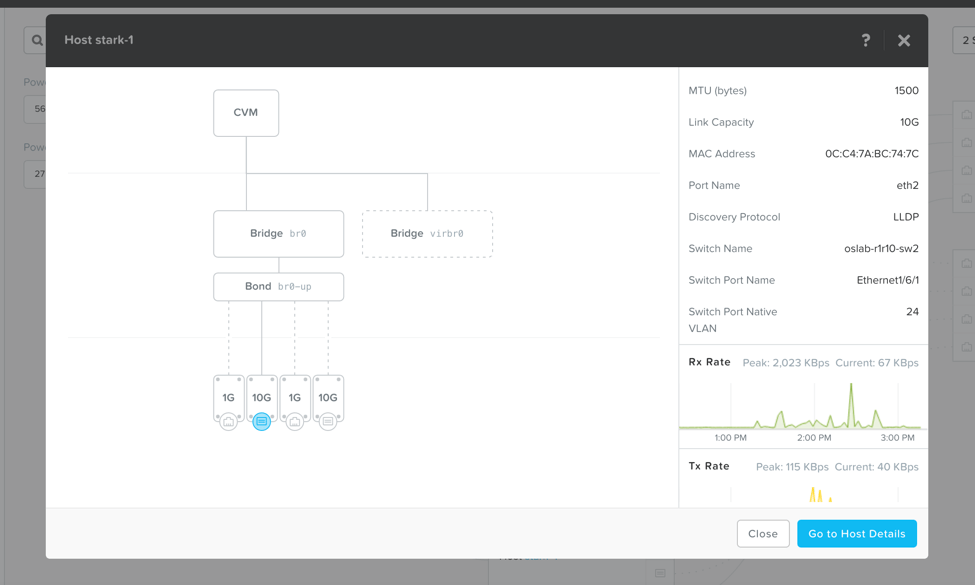
Our built-in NCC control script, Nutanix Cluster Check , which was previously only available from the CVM console, can now be launched and examined its output in the Prism interface. Are all the settings made correctly, is the FQDN resolved to DNS, is NTP responding, are there any problems in the network bridge? All of these checks can now be called from Prism Elements, which is built into every Nutanix host.
So what are we all about Acropolis? What's up with ESXi? There is also a novelty for him. Prism is so convenient, and the Web Console is sometimes so scary that it’s difficult to blame administrators for often asking us to manage some of the vSphere features from Prism . Now we have the opportunity from Prism to manage some routine administration operations not from vCenter, but from Prism. Stop and start the VM, migrate it from host to host, access its console - now you can not from Web Client vCenter, but from Prism. vCenter here, however, is still needed, we just pull its API with Prism for these tasks. But for some of the vSphere admins, this may seem useful and convenient, as it seems to me.
Acropolis File Service- our own NAS using the SMB 2.0 / 2.1 file protocol, distributed, decentralized, multi-threaded, single namespace, capable of storing tens of millions of files in a cluster, has grown to GA, General Available. This means that he is ready for production completely. And this does not mean that new features will not appear in the very near future. Plans to add SMB 3.0 and NFS, and something else.
But already now we have a good competitor to NAS cluster and unified storage.
At Acropolis Block Serviceadded support for several new OSs, among which, interestingly, ESXi 5.5 and 6.0. This means that the Nutanix cluster with ABS can operate as an external 10G iSCSI SDS storage not only for baremetal servers, for example, for non-x86 Oracle servers or other software that is impossible or impractical for some reason to drag on Nutanix. With ESXi support, the ability to use Nutanix as a repository for ESXi datastores is now added. However, you need to understand that using Nutanix as SDS is not the right goal, and Nutanix does not strive for such use, HCI (HyperConverged Infrastructure), in our opinion, is a much smarter and more progressive thing. For this reason, for example, we will not implement VAAI technology in ABS. ESXi support is seen as supportive for migration purposes, for example, or as a temporary solution. The pros and cons of HCI are much larger.
In addition to expanding the number of supported OSs, support was added for CHAP, IP Whitelist, Online Resizing for LUNs, as well as the ability to pin LUNs at the SSD level.
Finally, there is a new interesting opportunity for our SMB / SME and ROBO customers.
For such small offices, backup storage is often an issue. Nutanix has a built-in snapshot mechanism, but I would like to store these snapshots, in certain cases, outside the protected cluster. In principle, there are several options. You can send them to the central office, if the data transfer channel allows it, you can store them in a “virtual Nutanix” in the environment of a public cloud provider, for example AWS or Azure. But it would be ideal to do this on a local, but different, different from a combat cluster.
As you already know, the minimum configuration of a Nutanix cluster has 3 nodes. And in a situation where a small office is forced to buy only three more nodes for backup storage, this looks redundant. But for those playing with Nutanix CE, it’s no secret that, in principle, if you compromise on fault tolerance (and this is basically acceptable for storing backups), you can even upgrade Nutanix on one host.
And now we have a Single-node backup target , a special configuration for storing snapshots of the main cluster, a single-mode “pseudo-cluster”. You can’t deploy VM on it, it doesn’t work with third-party backup applications, but if the goal of storing snapshots on a separate system is then this is an interesting option.
The figure illustrates this diagram.
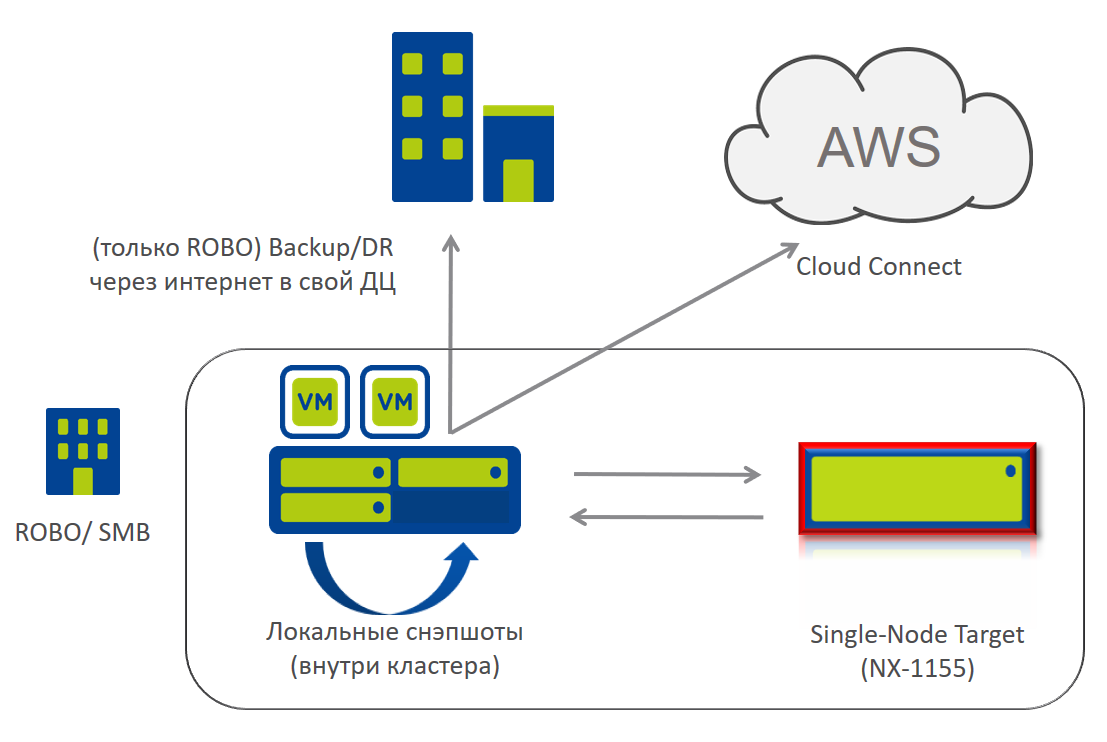
About 25 different new features remained unexamined and untold, they also include NVMe support (we do not have NVMe models in the lineup yet, but software already supports it), and support for up to 60TB of storage capacity per node, XenServer support for VDI infrastructures with 3D -GPU NVIDIA Tesla M60 / M10, implementation of CBT (Change Block Tracking) API for third-party backup applications, Metro Witness for our Metro Availability mechanism will allow us to better handle the situation Split Brain, Self-service restore mechanism that allows the VM user to independently mount and restore VM contents from sn shots, without the involvement of the administrator. We switched to a new, improved compression algorithm, changing within the Snappy system, which was prior to version 5.0 on LZ4HC, one of the most efficient data compression algorithms on disks today,

Finally, Nutanix with Acropolis Hypervisor is officially recognized as compatible for SAP Netweaver systems. Given SAP’s stunning conservatism regarding virtualization and technology, this is a breakthrough. Recognition of SAP compatibility means that Netweaver’s SAP systems can officially be deployed to HCI Nutanix on our Acropolis hypervisor. Ahead is SAP HANA, but how far ahead is HANA support so far I can’t tell you. We are all waiting for the release of the NUMA support release in Acropolis Hypervisor, and after that we will “punch” SAP about HANA. Optimistic - this could happen this year. Given that today SAP does not consider any virtualization for HANA systems at all, and supports only baremetal, this will be “a small step for the company, but a huge leap for humanity”.
So, a new major release was released, and, according to the reports of our technical support, already in the first month about 5% of our users in their systems switched to it only in January.

Not surprisingly, in addition to the listed features, we were able to optimize the code a little more and increase the performance of reading and writing to IOPS by about 20% ( AOS 4.7.3 , AOS 5.0 ), just by software-free update, on the same physical hardware. And this is another obvious advantage of Software-defined solutions.
